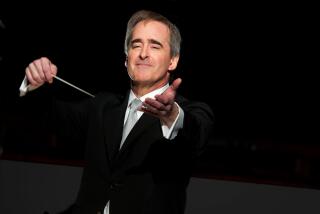O.C. classical society sees big spending hike in most recent season

Bucking a sense of retrenchment in the classical music world, including highly publicized recent cutbacks by New York’s Metropolitan Opera, the Philharmonic Society of Orange County increased its spending 36% during its most recent season and, thanks to its donors, did not go broke.
The society is Orange County’s leading presenter of touring orchestras, and sentiment was part of the reason for increasing spending to about $4.5 million, up from $3.3 million the previous season.
The 2013-14 season that ended last spring marked the organization’s 60th anniversary while serving as a farewell to its respected president and artistic director, Dean Corey, who retired after 21 years in charge. The bottom line was an unaudited budget surplus of $60,000, according to figures released recently by the Philharmonic Society.
But the organization still faces fiscal challenges. It had entered the 2013-14 season with a long-term debt of $797,000, which it has covered with bank lines of credit that cost it about $50,000 in annual interest.
Highlights of the 2013-14 season included performances by the Vienna Philharmonic, pianist Yuja Wang and a mammoth concert of Benjamin Britten’s “War Requiem” featuring more than 300 performers conducted by Los Angeles Opera music director James Conlon.
Those and other attractions worked no box office wonders, however: Ticket sales remained flat at about $1.1 million. But donors stepped up with $3.4 million in contributions, including proceeds from fund-raising events -- a big increase over the previous year’s $2.2 million. That made it possible for the Philharmonic Society to boost spending above the $4-million mark for the first time since 2007-08 without undermining its financial position.
The society was able to match a $1-million challenge grant from an anonymous donor during the season, spokeswoman Jean Hsu said, with 800 other givers teaming to match the $1 million by season’s end. Going forward, she said, two other donors, Catherine and James Emmi, have issued a $250,000 challenge grant to keep the fund-raising momentum going.
The Philharmonic Society operates essentially without a financial net. Its endowment entering Corey’s farewell season was just $568,000, according to its most recent available public financial reports.
Its long-term debt stems mainly from losses incurred in a difficult 2006-07 season. Back then it boosted programming and spent $4.9 million, expecting that the fall 2006 debut of Renee and Henry Segerstrom Concert Hall would be a magnet for ticket buyers.
After attendance and box office returns failed to materialize as expected, Corey theorized that local classical buffs had been faced with too much of a good thing, as the three leading presenters in the new hall all ramped up offerings and put on special events to celebrate its opening. (The others are the concert hall’s landlord, the Segerstrom Center for the Arts, and its leading tenant, the Pacific Symphony.) In hindsight, Corey said, supply had outstripped demand.
Hsu, the Philharmonic Society spokeswoman, said that it won’t be clear whether the 2013-14 financial performance allowed the organization to lower the long-term deficit until its audit for the season is finished.
Before retiring, Corey picked the coming 2014-15 season, which opens Oct. 11 with the London Philharmonic. That gave his successor, John Mangum, a veteran music programmer for the San Francisco Symphony, New York Philharmonic and Los Angeles Philharmonic, some breathing room to settle in and plan his own booking approach while building relationships with donors.
Follow @boehmm for arts news and features.
More to Read
The biggest entertainment stories
Get our big stories about Hollywood, film, television, music, arts, culture and more right in your inbox as soon as they publish.
You may occasionally receive promotional content from the Los Angeles Times.







